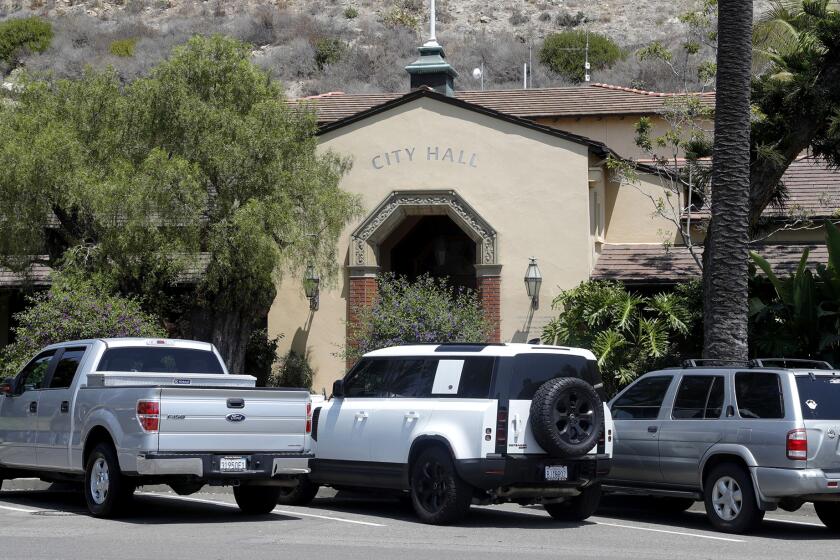Samueli Academy identifies educational opportunities for foster care teens
- Share via
Forty-six percent: That’s the statistic that Chris Simonsen said motivated him to act.
According to Simonsen, CEO of Orangewood Foundation, a Santa Ana-based nonprofit that serves the more than 2,000 foster youth throughout the county, nearly half of children in the California foster care system don’t graduate from high school.
“It’s very hard to get a job when you don’t have a high school diploma, and then it’s hard to find stable housing,” he said. “So our board said, ‘Let’s try to figure out a way that we can impact that statistic in a positive way, to get more youth in foster care to graduate.”
Five years ago, Orangewood opened Samueli Academy, a charter high school in Santa Ana that specifically caters to foster youth, and also serves low-income youth in the area.
One way Samueli Academy does this is by offering extra support staff who bridge students’ on-campus and off-campus lives, ensuring that all needs, including mental health, emotional support, food, clothing, housing and academics, are met.
“Here, we try to ask more questions,” said Sarah Davis, student success coordinator at Samueli Academy. “Instead of saying, ‘Why don’t you have a pencil? What happened to your school supplies?’ we ask, ‘Do you have any?’ Instead of coming at them, we ask more questions to have a better idea of what the child is dealing with.
“Here the kids get to be seen, they get to be heard,” she said.
For Violeta Vega, who graduated from Samueli Academy in 2017, the extra support made a difference in her ability to complete school. She started as a freshman, and mid-way through her studies she was placed in a foster home and separated from her family.
“Changing from being in a home to being with strangers was very, very difficult, but the school could understand since they’ve been dealing with kids like that the whole time,” she said. “It’s not that I got special treatment, but everybody was understanding of the situation. Having all those people focusing on me is what helped the most. Having them pushing me to finish was the biggest thing because I felt like I was breaking down.”
Vega is now a student at the University of Washington in Seattle on a pre-med track.
Samueli Academy’s curriculum is also innovative, said Anthony Saba, head of school, and designed to engage students who may be behind — or less interested — in school.
“Gone are the days of 45-minute lectures where you memorize things for a test,” Saba said. “We get their hands on real-world, authentic projects and teach to the same standards.”
In English class, freshmen read a non-fiction book called “The Boy Who Harnessed the Wind,” about a teenager in Malawi who built a windmill out of scraps in order to bring electricity to his village.
In science class, students learn about wind patterns and climate.
In engineering and design, they’re tasked with creating windmills out of everyday items to power their cell phones just like the teen in the book.
The students then hold an event to auction off their windmills, and donate the proceeds back to the teenager in the book so that he can build more windmills in Malawi.
“Four classes all work together on the same project — the same book — but it really brings learning to life,” Saba said. “It’s very engaging, and I know they’re learning.”
The numbers back the model.
According to Saba, Samueli Academy has a 97% attendance rate. Last year the school had its first group of seniors, and 115 of 116 graduated. Of those graduates, 98% went on to college.
Foster youth currently make up nearly 5% of Samueli students — about 20 out of 500 — but an innovative residential program that Simonsen hopes will be implemented in the next few years should help boost those numbers.
The long-term goal is to create housing for foster youth so that, similar to a boarding school, they have the option to live on-campus during the week or full-time.
The idea would help bring stability to foster youth, so that instead of moving and switching schools with each new foster family, they could live in one place throughout high school.
“Our experience shows that they move around often, and every time they move, they fall back academically, so they often aren’t working at grade level,” said Simonsen. “And then there’s the emotional piece of moving around a lot and not feeling like they’re a part of something — not being able to join athletic teams or clubs, or establish friendships because they’re not sure how long they’re going to be at that school.”
The residential model is also designed to assist relatives and potential foster families.
“Taking on a foster youth full-time, 24/7 is a big commitment that scares off some families,” Simonsen said. “If we could provide them an option where we provide the academic support, and all the care during the week is done through school, and they’re just supporting the youth on the weekends, they could feel like that’s something they could do. And then over time, they may feel that relationship has become so strong that they’ll find a way to bring that young person full-time into their home.”
Once the residential program is underway, Simonsen said that Samueli Academy’s goal is to have foster youth make up 15 to 20% of the student body.
Caitlin Yoshiko Kandil is a contributor to Times Community News.
All the latest on Orange County from Orange County.
Get our free TimesOC newsletter.
You may occasionally receive promotional content from the Daily Pilot.




